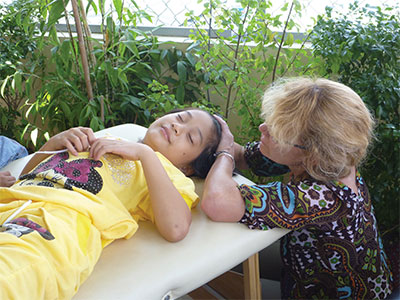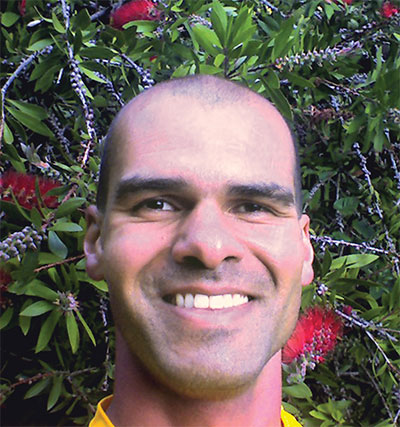
Features
Practice
Technique
A world of difference
If you were a massage therapist while the HIV/AIDS epidemic was emerging in the 1980s, you might well have wondered if giving a massage to a person with HIV would put you at risk of being infected. In those days, the public had little knowledge about how HIV is transmitted. Most people only knew AIDS was a fatal disease with no cure.
January 7, 2015 By Les May
If you were a massage therapist while the HIV/AIDS epidemic was emerging in the 1980s, you might well have wondered if giving a massage to a person with HIV would put you at risk of being infected. In those days, the public had little knowledge about how HIV is transmitted. Most people only knew AIDS was a fatal disease with no cure.
 |
|
| Massage treatments for orphan children living with AIDS help strengthen their immune system and improve their overall health.
|
Today, in countries where HIV/AIDS activism and awareness education have been relatively widespread and effective for many years, tremendous progress has been made toward eradicating HIV/AIDS stigma and discrimination against people living with HIV/AIDS. Most people have learned that HIV cannot be transmitted through skin-to-skin contact. Many, if not most, massage therapists are aware there is no risk of transmission when massaging people with HIV, unless blood is present.
In countries where HIV/AIDS activism and awareness education have been less successful, however, people with the disease are still likely to face severe discrimination and be treated as outcasts in their societies. In these countries, children with HIV whose parents have died or abandoned them are particularly at risk of suffering from a shortage of the nurturing touch, on which their health, well-being and development depend.
The non-profit organization Buds to Blossoms addresses the needs of such at-risk children through its Pediatric Massage Volunteer Program with AIDS Orphans and Orphans with Disabilities. This program brings international teams of volunteers to Vietnam several times a year to provide nurturing, therapeutic massage to ill and disadvantaged children.
The team works at several locations in Saigon, including an AIDS orphanage that’s home to fifteen children, another orphanage that cares for sixty disabled children, and a drop-in centre for forty AIDS orphans and other children affected by HIV who live with family members. The volunteers regularly work at no more than three or four locations for the duration of the three-week program. This enables them and the children to get to know each other and build rapport. It also maximizes the impact the program has on the children’s quality of life.
Positive interaction
The Buds to Blossoms Pediatric Massage Volunteer Program not only promotes the health and well-being of AIDS orphans and orphans with disabilities, it also creates opportunities for the children and volunteers to learn, grow and have fun together by sharing gentle massage. The volunteers’ time with the children is a joyful blend of nurturing touch, play, tranquility, song, smiles, hugs and laughter.
The inspiration for this program came from Suzanne Reese, an infant massage teacher who volunteered to provide massage to severely neglected children with congenital disorders and disabilities at an orphanage in Belarus. When Reese began working with the children, she found they were psychically traumatized and withered by the lack of nurturing contact. Yet, the children’s bodies unfolded and their spirits improved dramatically in a short time, thanks to the massages the received. The culture of the orphanage also changed as the children’s caregivers learned that children need human contact and affection to thrive.
Reese’s work has demonstrated that massage can play an important part in improving the health and quality of life of ill and disabled children in orphanages. Buds to Blossoms has taken this message to the other side of the world and partnered with several orphanages and other centres that provide care to disadvantaged children in Vietnam.
Massage is of particular value to the AIDS orphans because its immune system-strengthening effect can potentially improve their compromised health. A number of studies have pointed to this and other therapeutic effects of massage for children and adults with HIV/AIDS.
Massage also promotes the children’s well-being by bringing relief from pain and anxiety, and helping meet their emotional and developmental needs for one-on-one nurturing attention and touch.
Many of the orphans with disabilities that Buds to Blossoms team works with have contractions, a condition in which limbs are continually flexed and have decreased range of motion, sometimes to the point of being almost completely immobilized. The massages improve their mobility and lessen the discomfort of perpetually contracted muscles.
While the health benefits the Pediatric Massage Volunteer Program brings the children are key, its effects on their behaviour are equally impressive. At the overcrowded and understaffed orphanages, many of the children don’t receive adequate amounts of one-on-one contact from adults, so they become frustrated and tend to demand attention by acting out violently. As the children get used to receiving an abundance of gentle massage from Buds to Blossoms volunteers, they no longer need to seek attention and contact through aggressive behaviours. They’re more likely to reach out to hold hands, hug or offer a massage to the volunteers or to their peers or caregivers.
The volunteer massage program is also a learning opportunity for orphanage staff. They observe and work with the volunteers so that, over time, lovingly massaging the children becomes part of their routine. They interact with the children more gently and get frustrated with them less often.
As these positive changes begin to occur in the children and staff, the orphanages gradually become more nurturing, humane and safer for the children to grow up in.
Volunteering
People considering to participate in this unique program typically ask one question: What would have to happen for there to be a risk of my getting HIV when doing massage on people with HIV/AIDS, and how great would the risk be?
In the context of this volunteer program, there would only be a risk of transmission during massage if blood were present outside the body of a person with HIV – such as at the site of a wound. That blood could only cause HIV infection if it came into contact with the massage provider’s mucuous membranes (nostril, ear, lip, eyelid, etc.) or a break in their skin.
In the unlikely event of such contact, the risk of transmission is extremely low. According to the U.S. Centers for Disease Control, the risk in such cases would be under one in a thousand.
Prior to deployment, volunteers receive training on simple steps they can take to minimize the risk of coming into contact with HIV-infected blood – in case it’s present during a massage. These steps include checking oneself for areas of damaged skin and unhealed wounds before doing massage, and covering them with waterproof Band-Aids. A finger cot or rubber glove can be worn if waterproof Band-Aids don’t provide sufficient protection for a wound.
Therapists should also check the part of the person’s body they intend to massage for the presence of blood and unhealed wounds before beginning massage. If blood is found on the surface of the body, orphanage staff, who are trained to provide medical care to people with HIV, should be asked to wipe away the blood and cover the wound. The massage therapist should then keep at least a hand’s width away from unhealed wounds when providing massage in order to avoid contacting them.
Finally, therapists should immediately wash with soap and water if they accidentally come into contact with blood. They should also wash after giving massages and before touching themselves anywhere, whether or not contact with blood is believed to have occurred.
Buds to Blossoms’ approach to massage with children emphasizes gentle, nurturing touch; making the experience engaging and age-appropriate by incorporating song, nursery rhymes and playful movement; and asking permission to give massage.
Volunteers learn by working alongside veteran pediatric massage and infant massage therapists and teachers – acquiring a tremendous amount of hands-on experience during the program. This can be a unique opportunity to use one’s skills to be of service to disadvantaged children, while growing and developing as a massage therapist.
Ask your regulatory college or professional association if educational credits can be earned from joining the Buds to Blossoms Pediatric Massage Volunteer Program.
More information on Buds to Blossoms, including costs, dates and an online application form, can be found at www.budstoblossoms.org .
 |
|
Les May is the founder and president of Buds to Blossoms. He holds certifications as an infant massage instructor, pediatric massage therapist, and Esalen Massage practitioner. He is also the founder of the Kizuna Baby program through which volunteers provide massage to babies living in institutions in Japan.
Print this page